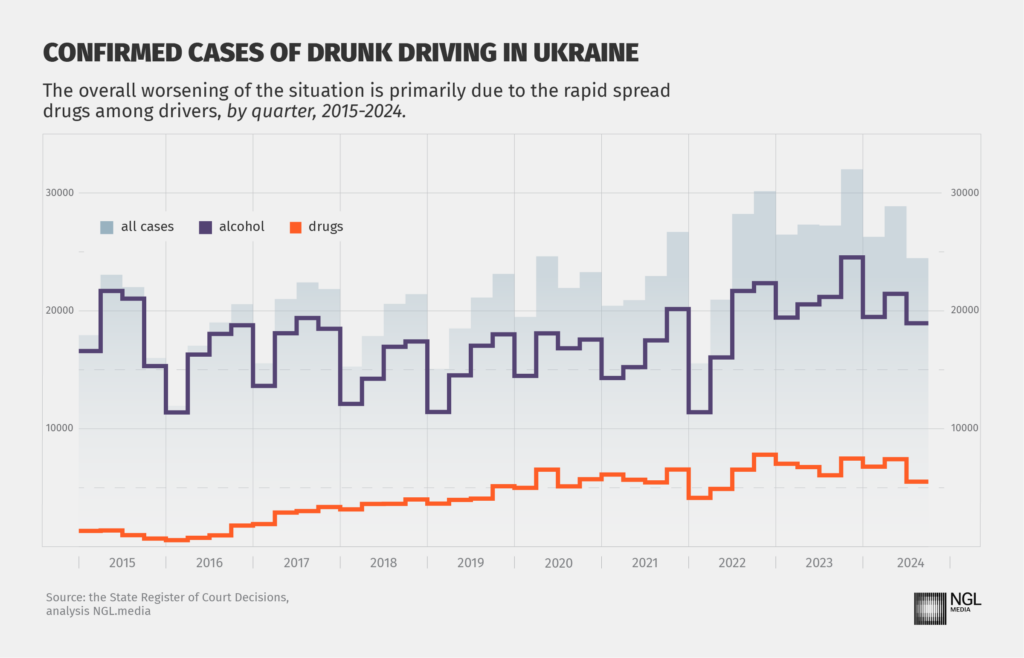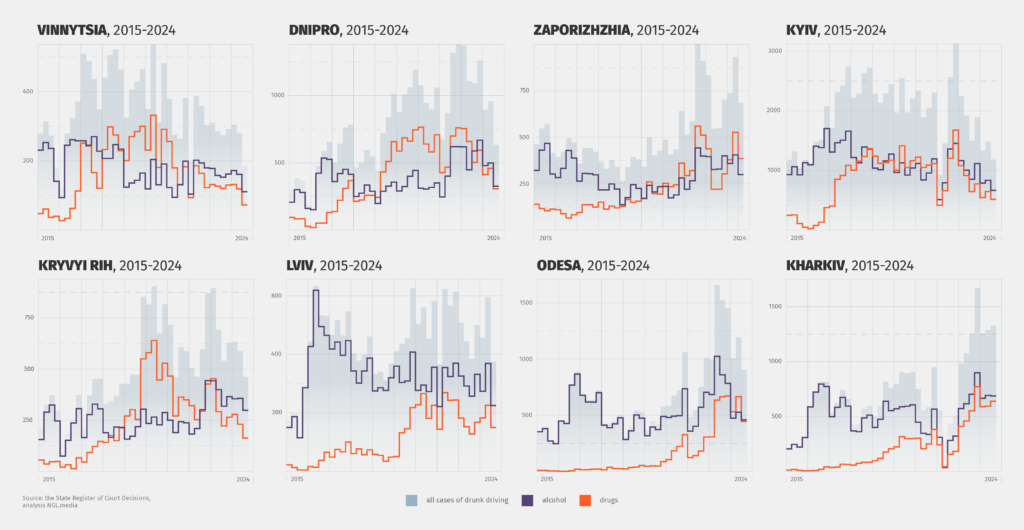The number of intoxicated drivers is constantly increasing in Ukraine. The share of Ukrainians, driving in the state of drug intoxication, has risen from 5.5% to 25% on average out of all the cases of intoxicated driving. In absolute figures, this situation looks much worse, and in many cities, the share of such drivers exceeds 50% already.
Yet nobody maintains comprehensive statistics on this problem in Ukraine. The patrol force publishes generalized quantitative reports each month without breaking them down into regions or cities.
So NGL.media decided to collect and analyze all the data about intoxicated driving in ten recent years using the court register, documenting all the confirmed cases. At the end of the text, you will find a database that allows you to search for specific cities and districts.
NGL.media publishes only exclusive investigations and analytics based on big data. Please support our work so we can make more content like this
On a Sunday morning of October 15 last year, 44-year-old Serhii Koroliov, driving his crossover, left the parking lot of a Truskavets hotel, “Rixos-Prykarpattya”, where he had spent some time. About 10 minutes later, while passing another car and driving at about 140 km per hour along the oncoming lane, he crushed into a passenger van, Volkswagen Caddy. That road accident took the lives of four people – a driver and three passengers of the Caddy. Four more, including the guilty driver, received severe traumas.
It was later discovered that at the moment of this road accident, Koroliov was in a state of drug intoxication. It was his usual condition. About two days before that, he had been detained in the same state in Lviv, and in several recent months, he had been fined for it at least five times. Half a year before that road accident, Koroliov’s driving licence had even been revoked, but it didn’t save the passengers of the Volkswagen Caddy.
Our streets and roads are becoming more dangerous
“Last year, we had an anti-record… 151 thousand cases with registered facts of driving a vehicle in the state of alcohol intoxication. In as few as four months of this year, we have had still unprecedented statistics: we have already registered about 50 thousand cases of driving a vehicle while being intoxicated”, said Oleksii Biloshytskyi, one of the heads of Ukraine’s road police in the footage of the national TV marathon several months ago.
His words are confirmed by statistics. For instance, in six recent years, the number of confirmed cases of intoxicated driving in Ukraine has increased by 50%. This is demonstrated by the analysis of about 850 thousand court rulings on proving the drivers guilty of intoxicated driving in 2015–2024.
Yet, the analysis by NGL.media shows that the main reason for this sharp rise has been a rapid increase in the number of cases when drivers use drugs. In ten years, the rate of alcohol consumption has increased only by 14%, while the use of drugs has risen more than six times. In some cities, the drivers use drugs more often than alcohol.
The spreading of drugs among drivers is especially evident in cities
The tendency towards a rapid increase in cases of intoxicated driving is observed in most large cities of Ukraine – and it looks even worse than the average rate for the country. For instance, as compared to 2015, in Lviv such cases are 14 times more frequent, and in frontline Kharkiv – 48 times more frequent.
The critical situation is evident in Dnipro, where the share of drug consumption among drivers exceeds the one for alcohol five times. It is true for Kryvyi Rih as well, where drugs were more common in 2019-2022.
It is noteworthy that until 2020 in Odesa, for instance, a smaller share of drivers with drug intoxication was registered than on average for the country. Yet in three recent years, the number of such drivers has increased ten times, and now it accounts for over 40% of all cases of intoxicated driving. For comparison, the average index for the country in 2024 is 25%.
Unfortunately, the tendency to more frequent drug consumption has not spared public transport. For instance, several days ago, in Lviv, a 50-year-old tram driver, in a state of alcohol and drug intoxication, ran down a woman with her two-year-old grandson on a pedestrian crossing.
Drugs alter consciousness almost immediately
The greatest danger of drugs lies in the fact that, contrary to alcohol, they alter human consciousness almost immediately – Oleh Fitkalo, a well-known Ukrainian narcologist and psychotherapist of the Lviv Medical University, explains in the conversation with NGL.media. In his words, the highest impact in the context of driving is made by cannabis, including synthetic cannabis, as it slows down the reaction and affects the mood.
“First and foremost, The increase in the number of drivers, intoxicated by drugs, demonstrates a higher rate of drug consumption by the entire population, which will then lead to a high rate of addictions and more mental disorders related to drug use,” Oleh Fitkalo said, highlighting the availability of such substances in Ukraine. “War enhances stressful activity among all these people, and people are used to putting this activity out with something, so drugs come to the fore, since they cope with this task fast.”
Before the full-scale invasion, the then Prosecutor General, Iryna Venediktova, was talking about the problem of higher drug distribution. In her words, up to 1.5 million Ukrainians use drugs regularly, and this number increases by 8-10% annually. “The tempo of increasing drug addiction in Ukraine is one of the highest indices in the world”, Venediktova stressed.
How can the number of intoxicated drivers on the roads be reduced?
More severe punishments have been used to solve this problem for several years now. In ten recent years, there have been two times in 2016 and 2021 that the responsibility was strengthened, which resulted in increasing the minimal fine five times, and the current punishment envisages obligatory revoking of the driver’s licence.
The punishment for causing road accidents involving victims has been made tougher as well. Since March 2021, the Criminal Code has a specific Article 286-1, foreseeing obligatory imprisonment for the intoxicated guilty driver. For instance, a Kyivite Serhii Koroliov, mentioned at the beginning of this article, was sentenced to 9 years of imprisonment according to this very article.
But could the road accident, caused by him, have been prevented? Koroliov had been fined multiple times; half a year before the tragedy, his driving licence had been revoked, yet he was still driving in his narcotic delirium until he killed four people.
And he is not the only one. For instance, after the very first case, a Kyivite Viacheslav Kovalchuk’s driving licence was revoked, but then he was fined three more times for driving after drug consumption. A year later, he caused a road accident; luckily, no victims were involved. Another bright example is Artem Stebliuk from Horishni Plavni in the Poltava region, who was fined for driving in an intoxicated state at least eight times during a year.
Andrii Kruten, the head of road police in the Lviv region, believes that it is impossible to prevent all such cases completely, but some steps can be made to improve the situation. “If the driver, whose licence has been revoked, still drives while being intoxicated, we enter the data about such person into the Unified register of pre-trial investigations, and there are cases when it results in proving a person guilty of a criminal offence for a failure to comply with the court ruling”, Kruten told NGL.media in a conversation. He says that the road police also impound the vehicles of such drivers if there are legal grounds to do so.
Another preventive measure could be the general public disapproval of intoxicated driving. “If you see an intoxicated driver, call the police otherwise it may end very badly – both for that driver and the people around him or her,” Andrii Kruten explains and highlights that 19 people have died because of intoxicated drivers in the Lviv region this year alone.
Cases of drug driving in cities



